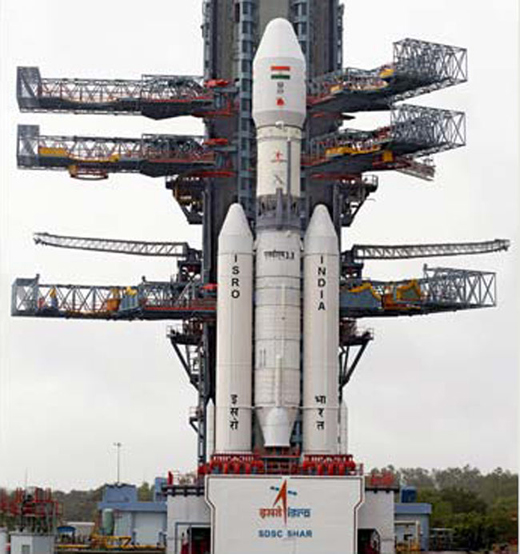ISRO launches its heaviest rocket GSLV Mk III
Mangalore Today News Network
Chennai, Dec 18, 2014: ISRO on Thursday launched its latest generation vehicle GSLV Mk III, also carrying the ’Crew Module Atmospheric Re-entry Experiment (CARE), from the Satish Dhawan Space Centre at Sriharikota, some 100 km from here.

The Mission Readiness Review and the Launch Authorisation Board, which met on Tuesday, has cleared the launch for December 18 at 9.30 AM, it said.
A senior ISRO official explained that the lesser duration of the countdown for the mission was due to the dummy cryogenic stage.
As per the plan, soon after the lift-off at Sriharikota, ISRO would study the flight validation of the complex atmospheric flight regime of LVM 3 and would also test the ability of the CREW module to re-enter the Earth’s atmosphere with thermal resistance, parachute deployment in cluster formation, aero braking system and apex cover separation procedures.
The CREW module would be separated from the rocket about 325.52 seconds after the lift-off at 126.16 km altitude. The specially made parachutes would help the module ’soft-crash’ in the Bay of Bengal, some few hundred km from Indira Point in the Andaman and Nicobar Islands, which would later be fetched by Indian Coast Guard ships.
"The entire exercise would be completed in around 20 to 30 minutes from lift-off in Sriharikota to splashing in the Bay of Bengal," the official said.
While the rocket cost ISRO Rs.140 crore, the crew module has taken another Rs.15 crore.
The 630-tonne GSLV-Mk III would carry the 3.65 tonne crew module even as the national space agency is equipping itself for its plan of sending astronauts into space eventually.
The Indian government has not approved any human mission to space presently.
Realisation of 42.4 metre tall GSLV Mk-III would help ISRO place heavier satellites into orbit.
GSLV Mk III is conceived and designed to make ISRO fully self-reliant in launching heavier communication satellites of INSAT-4 class, which weigh 4,500 to 5,000 kg. It would also enhance India’s capability to be a competitive player in the multi-million dollar commercial launch market.
Courtesy: Indiatoday
- LS Elections 2024: Phase 1 Of General Elections Record 62% Voter Turnout
- Yedapadavu: Several vehicles damaged as truck lost control and rams into them
- LS polls: Prohibitory orders across DK from April 24 to 26
- Uppinangady: 13 year old boy ends life
- Several parts of DK, Udupi receive good rainfall
- Union govt. gave grants over ₹1 lakh crore to Dakshina Kannada in the last decade: MLA Kamath
- Karnataka government focusing on harnessing more solar power, says Energy Minister
- Pedestrian fatally run over by tanker at Kulur
- Karkala: Forest fire engulfs vast tracts of land
- Maintenance works in Palakkad division; changes in train services
- Udupi: Bike-tipper collision claims rider’s life
- Kadaba acid attack victim writes CET in Mangaluru
- EC dismisses concerns as Kasaragod mock poll sparks row
- ABVP workers stage protest in Hubballi condemning female student’s murder
- LS elections 2024: PM Narendra Modi to campaign in Bengaluru and Chikkaballapura on April 20
- Mysuru man claims attacked for making song on PM Modi, police to probe
- Karnataka Congress corporator claims daughter killed due to ’love jihad’
- "Are we in Pak or Afghanistan?" Actor, husband attacked by mob in Bengaluru
- Air India suspends flights to Tel Aviv till April 30 amid Iran-Israel clash
- H5N1 strain of bird flu found in raw milk from infected animals: WHO
- Not love jihad: Karnataka govt amid outrage over woman’s murder in college
- Indian embassy advises Indians to reschedule non-essential travel as UAE reels under historic floods
- Almost 0% voting in 6 Nagaland districts over separate territory demand
- Amit Shah files nomination from Gandhinagar: ’Rose from booth worker to MP’
- Supreme Court’s big order on voter awareness rallies amid prohibitory orders
- New residential complex for the judges inaugurated in Mangaluru
- Absconding accused nabbed after 8 years
- Truck with cylinders turns turtle in Beltangady
- Bhoota Kola artist dies of cardiac arrest
- Development of the country should be our goal: Ganesh Karnik
- Container truck gets stuck under Modankap railway bridge
- Truck crushes bike’s pillion rider near BC Road
- Head constable dies of heart attack
- Udupi: PDO dismissed over financial irregularities
- CREDAI to resume Skill Development Program for Construction Workers in Mangaluru
- John B Monteiro elected president of Rachana Catholic Chamber of Commerce & Industry
- Sudhanshu Rai elected district president of All College Student Association
- Chief Minister to visit Mangaluru, Udupi on August 1
- Nitte University awards PhD degree to Tina Sheetal D’Souza
- Sachitha Nandagopal honoured by CMTAI for Community Service
- CITY INFORMATION
- TRAVEL
- TOURIST INFORMATION
- HEALTH CARE
- MISCELLANEOUS




 Write Comment
Write Comment E-Mail To a Friend
E-Mail To a Friend Facebook
Facebook Twitter
Twitter  Print
Print 

